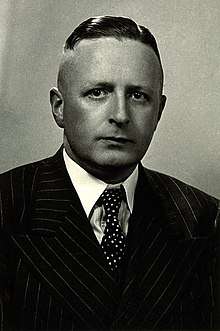Alexander Haddow
Sir Alexander Haddow FRS FRSE (18 January 1907 – 21 January 1976) was a Scottish physician and pathologist at the forefront of cancer research in the 1940s. He served as Director of the Institute of Cancer Research from 1946 to 1969. He was also President of the Universal Union Against Cancer.

His most important discovery was the Haddow Effect, by which a carcinogenic compound can be used to arrest a cancer whose origin is an unrelated carcinogen.[1]
Early life
Haddow was born on 18 January 1907 in Leven, Fife, Scotland to Margaret Docherty, daughter of a coachman, and William Haddow (d.1928) of Newharthill in Glasgow.[2][3] His father and grandfather were coal-miners.
The family moved to Broxburn, West Lothian where his father ran Green Tree Tavern, a small bar and hotel.[3] At age 10, Haddow fell ill with scarlet fever and remained frail and introverted. By age of 11, Haddow also suffered from appendicitis. He was much impressed by the family GP, Dr Alexander Scott, who treated him on both occasions and became his role model. Dr Scott was known for his studies of skin cancers in the local mining population. Haddow attended Broxburn High School then he attended Broxburn Academy, winning the Dux Medal.
Education
In 1929, Haddow graduated with an MB ChB from the University of Edinburgh.
Career
Haddow was an assistant and as a Houseman to Prof Thomas Jones Mackie at Edinburgh Royal Infirmary, also lecturing in bacteriology at the University of Edinburgh, where he became a full lecturer in 1932. The University awarded him with two doctorates (PhD 1937 and MD 1938).[4]
In 1936 he moved to London to join Ernest Kennaway's team at the Royal Cancer Hospital. In 1946 he succeeded Kennaway as Director of the Chester Beatty Research Institute, later renamed the Institute of Cancer Research.
In 1958 he was elected a Fellow of the Royal Society of London and in 1961 was elected a Fellow of the Royal Society of Edinburgh, where his proposers were Alan William Greenwood, Robert Cruikshank, Richard Swain and George Lightbody Montgomery. He was knighted by Queen Elizabeth II in 1966.[5]
In 1972 he retired to Chalfont St Giles. By this time he was almost totally blind due to diabetes, which also caused the loss of his limbs.[6]
Personal life
In 1932, Haddow married Lucia Lindsay Crosby Black (d.1968), a medical practitioner.[3] Their son William George Haddow was born in 1934..[2]
After the death of his first wife, he remarried in 1970 to Feo Standing, a scientific photographer. He gained two step-children.[2]
Haddow's suffered from diabetes and related blindness.[3] On 21 January 1976, Haddow died at Amersham General Hospital in Amersham, England. He was cremated.
References
- "Wellcome Library Western Manuscripts and Archives catalogue". archives.wellcome.ac.uk. Retrieved 24 August 2019.
- "Cancer Research - Obituary - Professor Sir Alexander Haddow". aacrjournals.org. May 1977. Retrieved 30 December 2018.
- "Alexander (Sir) Haddow". munksroll.rcplondon.ac.uk. Retrieved 30 December 2018.
- "Wellcome Library Western Manuscripts and Archives catalogue". archives.wellcome.ac.uk. Retrieved 24 August 2019.
- Biographical Index of Former Fellows of the Royal Society of Edinburgh 1783–2002 (PDF). The Royal Society of Edinburgh. July 2006. ISBN 0 902 198 84 X.
- Boyland, E. and Harris, R.J.C. (1977). "OBITUARY: Professor Sir Alexander Haddow" (PDF). cancerres.aacrjournals.org. Retrieved 24 August 2019.CS1 maint: multiple names: authors list (link)